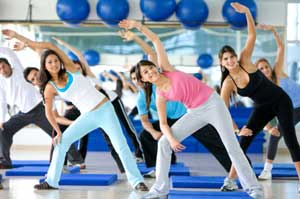The fitness industry has no shortage of hucksters, and they count on the public’s hunger for a quick fix to keep the money rolling in. They sell exercise products that, off the record, they admit are useless. They use scientific mumbo jumbo to promote products based on nothing more than wishful thinking. They pay celebrities big bucks to go on TV and lie. The Federal Trade Commission, the government agency that monitors truth in advertising, is aware of these scams and has boosted efforts to nail companies making fraudulent health and fitness claims. However, the advertising police are not unlike big-city cops: They only have the manpower to hunt down the most egregious offenders. And with the rise of the Internet, fitness crooks have proliferated. All of this means that you need to be a very savvy fitness consumer. Here we give you the lowdown on ten products that we consider to be a waste of money. We also offer tips on judging other fitness products that you may come across on TV commercials, on the Internet, in magazines, and in fitness-products and health-food stores.
Muscle Stimulation Machines (Electronic)
Type of products: Metal boxes that deliver a low-impulse jolt of electricity to muscles that are covered by electrodes. This jolt is supposed to tone and tighten muscles.
The Fact: The only way to strengthen your muscles is to work out. We think the reason electrical stimulation gizmos have such staying power is that electrical stimulus or transcutaneous electrical nerve stimulation (TENS) machines do have legitimate medical uses: They’re used by highly trained doctors and physical therapists to manage pain and help rehabilitate certain injuries. But they can cause serious injury from burns and electrical shocks when used by laypeople.
Burn More Calories: Metabolism Boosters
Type of products: Pills and powders intended to speed up your metabolism so that your body burns more calories during the course of the day without requiring you to increase activity. Several of these supplements — such as Ultra Burn, Citra Lean, and Hydroxycut — contain HCA (hydroxycitric acid), a form of citric acid found in fruits. Others contain chromium picolinate, a form of the mineral chromium, or ephedra (also called ma huang), an herbal stimulant. Some combine almost every ingredient known to mankind.
The Fact: Solid research shows that chromium picolinate has little nutritional value. Only two legitimate, published studies have even tested HCA in humans, and the results were contradictory. (Animal studies have shown the substance to be toxic, causing rat testicles to atrophy.) As for ephedra, the FDA has fielded more than 800 reports of medical problems from this stimulant, including heart attacks, strokes, seizures, and a nasty side-effect known as death. Ephedrine can be especially lethal for those with high blood pressure. It is banned in California.
Amphetamines and over-the-counter stimulants can indeed rev up your metabolism, but even if you can withstand the side-effects (such as increased blood pressure and heart rate), your body tends to adapt to these substances, so the effect is likely to be short-lived. The only safe and lasting way to boost your metabolic rate is to increase your muscle mass by lifting weights (and even that, as we explain in Chapter 11, isn’t going to have a magical effect).
Fat Prevention Pills
Type of products: Pills intended to prevent your body from absorbing the fat you eat. Chitosan — a substance that forms the hard shells of shellfish and insects — is a popular ingredient. Another is pyruvate, a substance that occurs naturally in the body and is involved in energy production.
The Fact: Sure, it would be nice if you could enjoy fried chicken, mounds of mashed potatoes and gravy, butter, rolls, ice cream, and cake — all without gaining weight. But guess what? You can’t! We don’t know whether pyruvate and chitosan are beneficial for weight loss. We do know that both Fat Trapper and Exercise in a Bottle can run you as much as $300 a month — a whopping $3,600 a year. That’s ten times the cost of many gym memberships. If you’re serious about dropping body fat, stay away from high-fat foods and get plenty of the type of exercise that doesn’t come in a bottle.
Anti-Cellulite Products
Type of products: Creams and gels intended to eliminate cellulite, the puckery fat that forms on the butt, hips, and thighs of most women and some men. What are the magic ingredients? Celanese pills contain, among other things, gingko biloba, sweet clover, grape seed bioflavonoid, and dried fucus vesiculosus (a kelp-like seaweed found off the Atlantic coasts of Europe). Lipofactor cream is made of “biotechnologically derived elements a/y.” We have absolutely no idea what this means, but this phrase is repeated all over the Internet.
The Fact: Talk about scientific mumbo jumbo! No legitimate research exists to show that any pill or cream can reduce cellulite. Physiologically speaking, cellulite doesn’t even exist. The term is marketing hype for plain old fat that clumps at various points on your body. The ripple effect is caused by a network of connective tissue fibers that attach muscle to skin and compartmentalize the fat like stitching on a quilt. You reduce cellulite the same way you reduce any fat: through a healthy diet and regular exercise. However, you may never lose the ripples. For some people, they’re a genetic fact of life.
Exercise With Ease
Type of products: These contraptions are the player pianos of exercise machines. They move whether you’re holding on or not. Consider the Stretch-A-Cizer, essentially a chair with a handlebar mounted above the seat back. “All you do is sit on the seat and hold onto the exercise bar while it goes through the motions,” explains an Internet ad for this $1,200 electric contraption (freight prepaid!). Also in this category: the Chi Machine Aerobic Exerciser. You lie on your back on the floor, place your ankles on the machine’s contoured footrest, flip a switch, and let this $460 gizmo toss you around like a fish out of water. “This is not a 10-kilometer run kind of workout, where one gets all sweaty and exhausted,” the Chi Machine Web site reports. “Instead you lie down, relax, [and] have a ‘workout.’”
The Fact: This is all a bunch of baloney. We don’t think we have to tell you why you won’t get thin by lying on the floor and having electrical impulses shoot up your spine so you flop around like a fish — even if you do this five times a day for 15 minutes, as the Chi Machine literature recommends.
Spot-Reducing Products
Type of products: Abdominal gizmos, neoprene “waist trimmer” belts, neck toners, “reducing” shorts — there’s no shortage of products that profess to melt the fat on a particularly blubbery spot on your body. In response to a crackdown by the Federal Trade Commission, many abdominal-gadget manufacturers have stopped making the direct claim that their products will cause weight loss in the abdominal area. However, they haven’t stopped implying that this will happen, firming and flattening abs, melting excess fat, and so on.
The Fact: The concept of spot-reducing is bogus; you can’t pick and choose where on your body you’ll lose fat. Abdominal exercises can only strengthen your abdominals (and many of them don’t even do a good job of that). To lose that gut, you have to embark on a sensible eating and exercise program — an approach that will reduce your overall body fat. Some of this body fat is likely to come from your midsection.
Sweat In Winters: Weight-Loss Clothing
Type of products: Vinyl and synthetic rubber exercise suits that make you sweat like it’s August in New Orleans.
The Fact: It doesn’t matter whose heat you use: Reducing inches by sweating profusely can put you in serious danger. People have died from wearing vinyl and rubber suits after working out in the heat or wearing the clothing over a long period of time. Cause of death: extreme dehydration or a form of blood poisoning brought on when chemicals from the suit escape into the bloodstream. We think suggesting that these suits can be worn for “the most strenuous activities” is particularly appalling. The more strenuous the activity, the more important it is to wear clothing that lets your skin breathe.
No Time For Workouts? Products For You
Type of products: ROM, a popular infomercial machine that looks like a combination stepper and indoor bicycle. The idea is that the machine offers such a phenomenal cardio and flexibility workout that you can get into the shape of your life in just four minutes per day.
The Fact: No four-minute cardiovascular workout will give you significant strength-training or weight-loss benefits. Certainly this contraption is no substitute for ten gym machines. And it doesn’t burn nearly three times the calories of a treadmill. (Machines don’t burn calories; people do. The number of calories you burn per minute depends on how hard you push. Some machines do allow you to work at a more intense pace than others, but the Romfab claim is totally unfounded.)
Cardio Machine Knockoffs For Gyms
Type of products: Cheapo treadmills, stair-climbers, and elliptical trainers that profess to work and feel exactly the same as the cardio equipment found in health clubs. You can find these at sporting-goods stores, online, and in mailorder catalogs.
The Fact: You simply can’t buy sturdy, high-tech aerobic machinery for the price of dinner at a fancy restaurant. Top-quality machines cost thousands of dollars for a reason: They’re based on years of scientific research and the study of body biomechanics. The angle of movement, the placement of the seat, how far your legs can move — all these important features are based on solid engineering. That’s usually not the case with cardio knockoffs. After a while, you may find that your back hurts or your knees ache because of poor design.
What’s more, these contraptions aren’t as sturdy as the gym versions. When you step on the treadmill at the gym, you don’t feel the walking belt sink or the handrails wobble. Suzanne almost toppled over while testing one of these at a trade show. And several people have filed lawsuits after allegedly hurting themselves on cheapo machines while trying them out in the store. One more caveat: Cheap cardio machines usually don’t come with good warranties — usually 90 days or less — compared to 1 to 3 years for highend machines. See Chapter 20 for tips on buying high-quality cardio machines for your home.
Workout With Hand Weights
Type of products: Dumbbells that weigh 1 to 5 pounds and are designed to be held while running, jogging, power walking, and doing step aerobics. Many of these products claim to combine strength training with aerobic conditioning in one workout, while causing you to burn extra calories.
The Fact: People who power walk with weights in their hands look quite serious and impressive, but the truth is, these weights aren’t doing them any good. Research on walkers shows that carrying hand weights burns only 10 to 15 percent more calories — a mere 20 to 30 calories over the course of an hour, at least half of which come from exaggerating your arm swing, not from the weights. (To put this in perspective: Speeding up from a 3-mph pace to a 4-mph pace burns an extra 54 calories.)
Research on aerobic dancers suggests that you may actually burn fewer calories holding hand weights than holding nothing at all. That’s because weight-holding exercisers must keep both arm and leg movements tight and controlled. In other words, you don’t move your body as much or as far because if you flail the weights around, you get thrown off balance. As a result, you burn fewer calories. Also, swinging hand weights vigorously can place undue stress on delicate upper-body joints such as the shoulder, elbow, and wrist. Due to a concept called torque, there are points in your arm swing when a weight exerts up to ten times the usual force on your joints. In other words, a measly 3-pound weight will place up to 30 pounds of force on those delicate joints. Plus, this force is delivered in a jerky manner, which can do a lot of damage.























